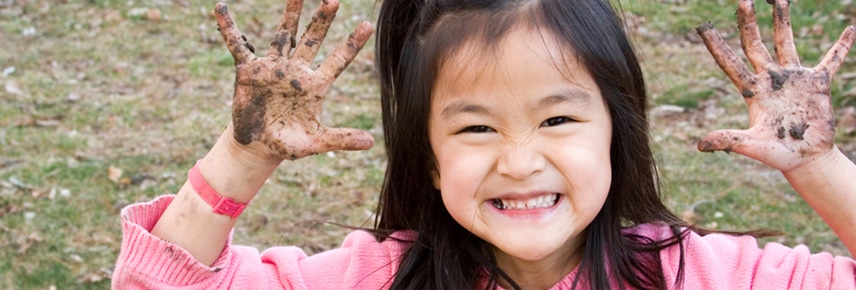- Bennett, C et al. 2018. Little People, Big Lives: Foundations for healthy Australian children in the 21st century. University of Notre Dame Sydney. Available online: [link]
- YouGovGalaxy. Data on file. 2018.

Rediscovering the lost art of play time
Remember when you bought your kids toys and they ended up just playing games with the box?
We didn’t realise it then, but that simple box was actually one of the best gifts we could give our child – the gift of imagination.
Devices are powerful tools that provide many educational benefits. But too much time on screens can take away from the movement needed for growing bodies and the cognitive and practical life skills that are best developed through active play – unstructured play that combines physical activity with self-expression and imagination.
Active play can be anything from symbolic play (using objects in an imaginative way, like a box into a race car), physical play (hopscotch, tag, hide-and-seek), and make-believe or role-play (playing pirates or superheroes).1
Here are some ways to help rediscover the art of “play time”.
Put ‘boredom’ back in its box
I’m bored! We can all relate to the struggle of what comes after those two little words are called out. In fact, YouGovGalaxy research revealed that 85% of parents are used to their child saying that they are bored on school holidays, with 26% going to extreme lengths to try to entertain their kids when they’re bored.
But far from being an unnecessary ‘evil’, the Little People, Big Lives report found that boredom plays an essential role in developing creativity, resilience, and resourcefulness.
It’s often more positive for children to find their own way out of boredom by engaging in active play, than to be provided entertainment upon request.1
It allows children to explore their environment with imagination and develop skills like resourcefulness, adaptiveness, creative thinking and the ability to productively and positively respond to boredom. Role-play and game-creation heightens their creative problem-solving abilities, and nurtures positive leadership and teamwork qualities.1 Can’t think of what to do? Create a Boredom Box! Sit down with your kids to write down every play activity you can think of on little paper notes and put them in a box. Whenever you hear those two little words - point them to the boredom box for inspiration.
Why not go a step further and colour-code your notes based on a points system to encourage more physically active forms of play? For example, a blue note could be one point for something like “doing a puzzle”, while a red note could be three points for “playing a game of cricket in the yard”. The more points they accumulate each month, there are rewards they can unlock.
Get back in touch with nature
Let’s be honest – with the ever-growing selection of food delivery apps, streaming services, and online games available at the touch of our fingertips - it’s getting easier to find reasons to stay indoors! So, it’s no surprise that the University of Notre Dame found that less than a quarter of Australian children are currently meeting the minimum physical activity recommendations.1
If you have a backyard or pool, make the area as playtime-friendly as possible and encourage kids to get outside. For city-dwelling or apartment-based families, it’s important to schedule time to outdoors, especially on the weekends.
Try making a Sunday afternoon walk to the local park a weekly ritual. Bring along balls and other toys they can play games with and be sure to join in the fun yourself!
Turn their interests into a platform for play
Can you remember what your biggest obsession was when you were a kid? Whether it’s digging dinosaur fossils, performing plays, or collecting Pokémon, every kid gets absorbed in a hobby that can sometimes consume their every moment! It’s great for kids to express special interests, but how do you make sure they’re not so engrossed that they forget to get outside and move? Why not try making the most of their natural curiosities by thinking of fun ways they can express their interests in a more physically active way?
If your kids love reading or watching TV, encourage them to ‘recreate’ one of their favourite stories using dress-ups, sheets and other items. If they love listening to music on their device, encourage them to create a dance routine and put on performance for the family.
Every child has an interest that can be transformed into active play time. All you need is to tap into your inner child and think a little outside the box!
Learn more about the benefits of physical activity and playtime for your child by downloading the Little People Big Lives report.

The latest nutrition advice, plus health and wellness tips delivered to your inbox monthly

